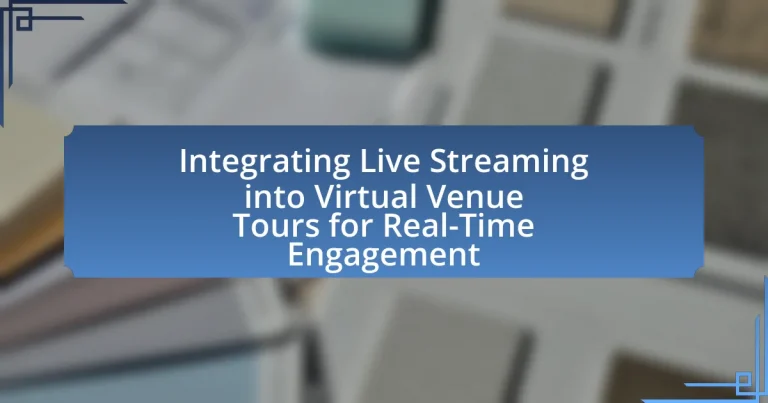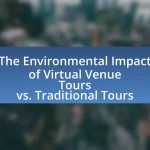Integrating live streaming into virtual venue tours enhances real-time engagement by allowing participants to interact with hosts and the environment as if they were physically present. This approach significantly improves user experience through immediate feedback, fostering a sense of community and increasing viewer retention. Key technologies such as video encoding software, content delivery networks, and streaming protocols are essential for seamless integration. The article also addresses the challenges of technical limitations and user experience issues while highlighting best practices for maximizing audience engagement and reach. Additionally, it explores how businesses can leverage this integration for marketing and revenue opportunities, ultimately enhancing brand perception and customer satisfaction.
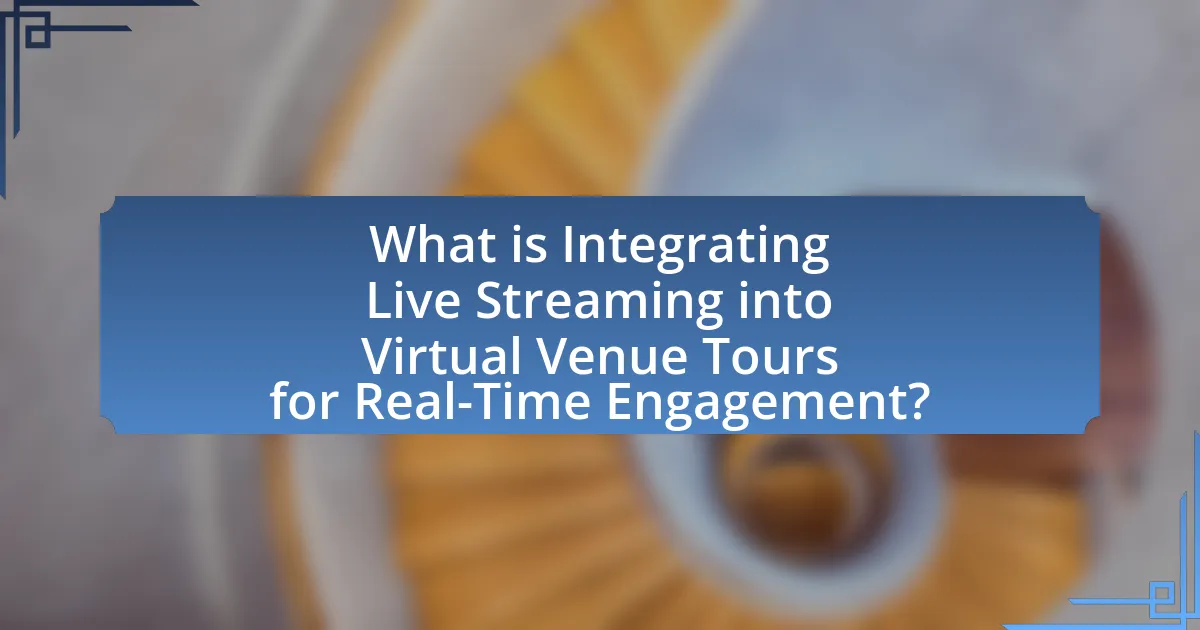
What is Integrating Live Streaming into Virtual Venue Tours for Real-Time Engagement?
Integrating live streaming into virtual venue tours for real-time engagement involves combining live video broadcasting with immersive online tours of venues, allowing participants to interact with the environment and hosts in real-time. This integration enhances user experience by providing immediate feedback, enabling questions, and fostering a sense of presence, which is crucial for engagement. For instance, a study by the Interactive Advertising Bureau found that live video can increase viewer engagement by up to 10 times compared to pre-recorded content, demonstrating the effectiveness of this approach in maintaining audience interest and participation.
How does live streaming enhance virtual venue tours?
Live streaming enhances virtual venue tours by providing real-time interaction and engagement between hosts and viewers. This immediacy allows participants to ask questions, receive instant feedback, and experience the venue as if they were physically present. According to a study by Livestream and New York Magazine, 80% of consumers prefer live video over traditional social media posts, indicating a strong preference for interactive content. This engagement not only increases viewer retention but also fosters a sense of community among participants, making virtual tours more immersive and impactful.
What technologies are essential for integrating live streaming?
Essential technologies for integrating live streaming include video encoding software, content delivery networks (CDNs), and streaming protocols. Video encoding software, such as OBS Studio or Wirecast, compresses and formats video for transmission. CDNs, like Akamai or Cloudflare, distribute the stream efficiently across various locations, ensuring low latency and high availability. Streaming protocols, including RTMP (Real-Time Messaging Protocol) and HLS (HTTP Live Streaming), facilitate the transmission of video data over the internet, allowing for real-time engagement. These technologies collectively enable seamless live streaming experiences in virtual venue tours.
How does real-time engagement impact user experience?
Real-time engagement significantly enhances user experience by providing immediate interaction and feedback during virtual venue tours. This immediacy fosters a sense of connection and involvement, making users feel more engaged and valued. Research indicates that 70% of users prefer real-time communication, as it allows for instant clarification and personalized experiences, which are crucial in virtual environments. Additionally, platforms that incorporate live streaming report a 30% increase in user retention, demonstrating that real-time engagement not only enriches the experience but also encourages users to stay longer and explore more.
What are the key components of a successful integration?
The key components of a successful integration of live streaming into virtual venue tours for real-time engagement include seamless technology integration, user-friendly interfaces, high-quality audio and video, interactive features, and robust support systems. Seamless technology integration ensures that live streaming platforms work smoothly with virtual tour software, allowing for a cohesive user experience. User-friendly interfaces facilitate easy navigation for participants, enhancing engagement. High-quality audio and video are critical for maintaining viewer interest and ensuring clear communication. Interactive features, such as live chat and polls, foster real-time interaction between hosts and viewers, increasing engagement levels. Finally, robust support systems, including technical assistance and troubleshooting resources, are essential to address any issues that may arise during the live streaming process, ensuring a smooth experience for all users.
What role does user interaction play in live streaming?
User interaction is crucial in live streaming as it enhances viewer engagement and fosters a sense of community. When users participate through comments, reactions, or polls, they create a dynamic environment that keeps the content lively and relevant. Research indicates that streams with high levels of interaction can increase viewer retention by up to 80%, demonstrating that active participation significantly impacts audience loyalty and satisfaction. This interaction not only enriches the viewing experience but also provides valuable feedback to content creators, allowing them to tailor their offerings to audience preferences.
How can content be tailored for live streaming during tours?
Content can be tailored for live streaming during tours by focusing on real-time interaction, localized storytelling, and audience engagement strategies. Real-time interaction can be achieved through live Q&A sessions, polls, and chat features that allow viewers to participate actively. Localized storytelling enhances the experience by incorporating unique aspects of the venue, such as historical anecdotes or behind-the-scenes insights, which resonate with the audience. Audience engagement strategies, such as inviting viewers to share their experiences or preferences, can create a more immersive environment. These methods have been shown to increase viewer retention and satisfaction, as evidenced by studies indicating that interactive content can boost engagement rates by up to 80%.
What challenges are associated with this integration?
The challenges associated with integrating live streaming into virtual venue tours for real-time engagement include technical limitations, user experience issues, and content synchronization difficulties. Technical limitations often arise from bandwidth constraints, which can affect video quality and streaming reliability, particularly in areas with poor internet connectivity. User experience issues may stem from the need for intuitive interfaces that accommodate both live streaming and virtual navigation, ensuring that users can easily interact with the content without confusion. Additionally, content synchronization difficulties occur when aligning live video feeds with pre-recorded or interactive elements, which can disrupt the flow of the tour and diminish engagement. These challenges highlight the complexity of creating a seamless integration that meets user expectations while maintaining high-quality performance.
How can technical issues be mitigated during live streaming?
Technical issues during live streaming can be mitigated by ensuring a stable internet connection, utilizing high-quality equipment, and conducting thorough pre-event testing. A stable internet connection, ideally with a wired Ethernet setup, minimizes disruptions caused by Wi-Fi fluctuations. High-quality cameras and microphones enhance audio-visual clarity, reducing the likelihood of technical failures. Additionally, pre-event testing, which includes checking all equipment and conducting trial runs, helps identify potential issues before the actual live stream. According to a study by Livestream, 67% of viewers reported that video quality significantly impacts their engagement, underscoring the importance of these mitigation strategies.
What are the potential pitfalls of real-time engagement?
The potential pitfalls of real-time engagement include technical issues, audience distraction, and content misalignment. Technical issues, such as poor internet connectivity or software malfunctions, can disrupt the streaming experience, leading to viewer frustration and disengagement. Audience distraction occurs when viewers multitask or are not fully focused on the content, diminishing the effectiveness of the engagement. Content misalignment happens when the live stream does not resonate with the audience’s interests or expectations, resulting in lower participation and interaction rates. These pitfalls can significantly hinder the success of real-time engagement initiatives in virtual venue tours.
How can businesses leverage this integration for marketing?
Businesses can leverage the integration of live streaming into virtual venue tours for marketing by enhancing customer engagement and expanding their reach. This integration allows businesses to showcase their venues in real-time, providing an interactive experience that can attract potential clients and increase conversion rates. For instance, a study by Eventbrite found that 70% of consumers prefer to watch live video over traditional social media posts, indicating a strong preference for real-time content. By utilizing live streaming, businesses can create immersive experiences that highlight unique features of their venues, answer questions instantly, and foster a sense of community among viewers, ultimately driving higher interest and bookings.
What strategies can enhance audience reach during live tours?
Integrating live streaming into virtual venue tours significantly enhances audience reach by allowing real-time engagement with a broader audience. Utilizing platforms like YouTube Live or Facebook Live enables performers to connect with fans who cannot attend in person, thereby increasing viewership. For instance, a study by the International Journal of Event Management Research found that live streaming can increase audience numbers by up to 30%, as it removes geographical barriers. Additionally, promoting live streams through social media channels and email newsletters can further amplify reach, as these methods effectively target existing fan bases and attract new viewers.
How does live streaming influence brand perception?
Live streaming positively influences brand perception by enhancing authenticity and engagement. Brands that utilize live streaming create a direct connection with their audience, fostering trust and transparency. According to a study by Livestream and New York Magazine, 80% of consumers prefer to watch live videos from a brand rather than read a blog, indicating that live streaming effectively captures attention and builds a more relatable brand image. This real-time interaction allows brands to showcase their personality and values, further solidifying consumer loyalty and enhancing overall brand perception.
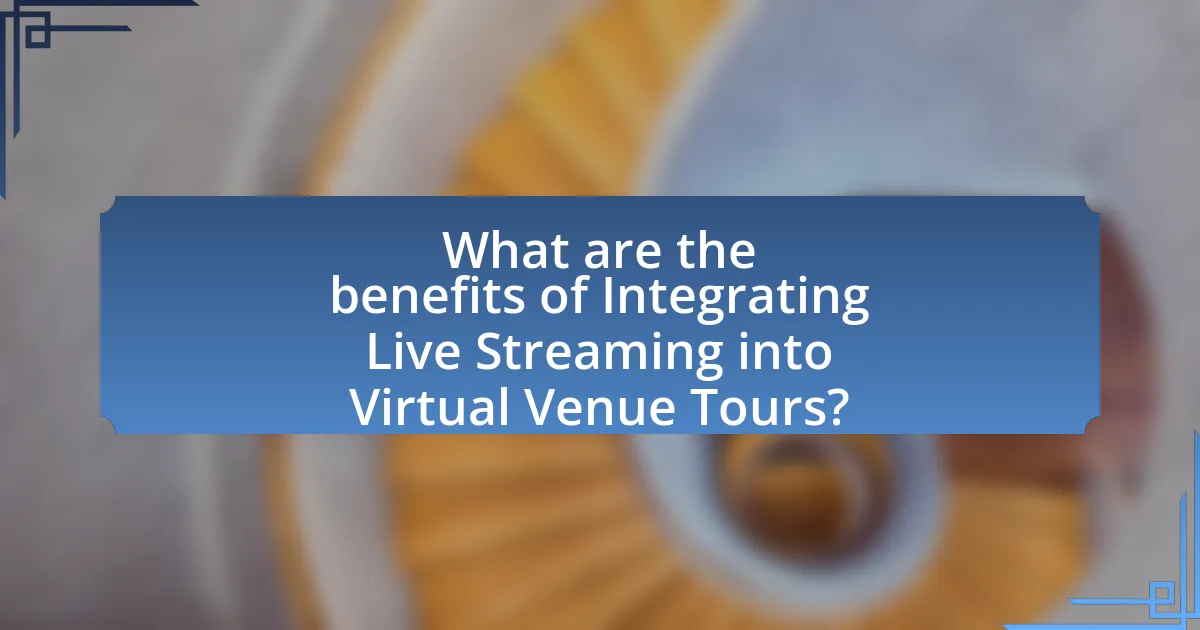
What are the benefits of Integrating Live Streaming into Virtual Venue Tours?
Integrating live streaming into virtual venue tours enhances real-time engagement by allowing participants to interact with the tour guide and ask questions as the tour unfolds. This interactivity increases viewer retention and satisfaction, as evidenced by a study from the Interactive Advertising Bureau, which found that live video generates 27% more engagement than pre-recorded content. Additionally, live streaming can reach a broader audience, breaking geographical barriers and enabling participation from individuals who may not be able to visit the venue in person. This expanded reach can lead to increased interest and potential bookings, as highlighted by a report from Eventbrite, which noted that events with live streaming options saw a 30% increase in attendance.
How does this integration improve customer engagement?
Integrating live streaming into virtual venue tours significantly improves customer engagement by providing real-time interaction opportunities. This integration allows customers to ask questions, receive immediate responses, and participate in discussions during the tour, enhancing their overall experience. Research indicates that interactive elements in virtual experiences can increase user engagement by up to 70%, as they foster a sense of presence and connection. Additionally, live streaming can showcase unique features of the venue dynamically, capturing customer interest and encouraging them to explore further.
What metrics can be used to measure engagement success?
Metrics that can be used to measure engagement success include viewer retention rate, interaction rate, and conversion rate. Viewer retention rate indicates how long participants stay engaged during a live stream, with higher percentages suggesting effective content delivery. Interaction rate measures the level of audience participation through comments, likes, and shares, reflecting the content’s ability to provoke responses. Conversion rate tracks the percentage of viewers who take a desired action, such as signing up for a newsletter or making a purchase, demonstrating the effectiveness of the engagement strategy. These metrics provide concrete insights into audience behavior and content effectiveness in the context of live streaming for virtual venue tours.
How does real-time feedback enhance the tour experience?
Real-time feedback enhances the tour experience by allowing immediate adjustments based on participant reactions and inquiries. This responsiveness fosters a more engaging and personalized environment, as tour guides can address questions or concerns on the spot, ensuring that the content remains relevant and interesting. For instance, studies show that interactive elements in virtual tours, such as live Q&A sessions, significantly increase user satisfaction and retention rates, demonstrating the effectiveness of real-time engagement in enhancing overall tour quality.
What advantages does live streaming offer to venue operators?
Live streaming offers venue operators increased audience reach and enhanced engagement opportunities. By broadcasting events in real-time, operators can attract viewers who are unable to attend in person, thereby expanding their market. For instance, a study by Statista indicates that live streaming can increase event attendance by up to 30%, as it allows remote participants to experience the event as if they were physically present. Additionally, live streaming facilitates real-time interaction through chat features, enabling operators to engage with their audience directly, which can lead to higher customer satisfaction and loyalty.
How can live streaming increase revenue opportunities?
Live streaming can increase revenue opportunities by enabling real-time engagement with audiences, which enhances customer interaction and drives sales. For instance, businesses can host live events, product launches, or virtual tours that allow viewers to make purchases directly during the stream, capitalizing on the immediacy of the experience. According to a report by Livestream and New York Magazine, 80% of consumers prefer to watch live videos from brands rather than read blog posts, indicating a strong preference for interactive content that can lead to higher conversion rates. Additionally, live streaming can facilitate sponsorships and partnerships, where brands pay to be featured during the event, further diversifying revenue streams.
What are the long-term benefits of adopting this technology?
The long-term benefits of adopting live streaming technology in virtual venue tours include enhanced audience reach, increased engagement, and improved customer insights. By integrating live streaming, venues can attract a global audience, allowing them to showcase events and experiences to individuals who may not be able to attend in person. This broader reach can lead to higher ticket sales and increased brand visibility.
Furthermore, live streaming fosters real-time interaction, enabling viewers to engage with hosts and ask questions, which enhances the overall experience and encourages repeat participation. According to a study by Livestream and New York Magazine, 80% of consumers prefer to watch live videos from brands rather than read blog posts, highlighting the effectiveness of this engagement method.
Additionally, the data collected from live streaming interactions can provide valuable insights into audience preferences and behaviors, allowing venues to tailor future offerings more effectively. This data-driven approach can lead to improved customer satisfaction and loyalty over time.
How does this integration cater to diverse audiences?
This integration caters to diverse audiences by providing real-time interaction and accessibility during virtual venue tours. Live streaming allows participants from various geographical locations to engage simultaneously, breaking down barriers related to distance and travel costs. Additionally, features such as multilingual support and customizable viewing options enhance the experience for users with different preferences and needs. For instance, a study by the Pew Research Center indicates that 53% of adults prefer online experiences that offer interactive elements, demonstrating the demand for engaging formats that this integration fulfills.
What demographic trends support the use of live streaming?
The demographic trends supporting the use of live streaming include the increasing engagement of younger audiences, particularly Generation Z and Millennials, who prefer real-time interaction and authentic content. According to a report by Statista, 70% of Gen Z and 67% of Millennials engage with live streaming content, highlighting their preference for platforms that offer immediate connection and participation. Additionally, the rise of mobile device usage among these demographics facilitates access to live streaming, with 54% of live stream viewers accessing content via smartphones, as reported by Livestream. This trend indicates a significant shift towards live streaming as a preferred medium for communication and entertainment among younger audiences.
How can accessibility be improved through live streaming?
Accessibility can be improved through live streaming by providing real-time captioning and sign language interpretation, which ensures that individuals with hearing impairments can fully engage with the content. Research indicates that approximately 15% of adults in the U.S. experience some form of hearing loss, highlighting the necessity for inclusive practices. Additionally, live streaming allows for remote participation, enabling individuals with mobility challenges to access events they otherwise could not attend. By utilizing platforms that support these features, organizations can enhance the overall accessibility of their virtual venue tours, making them more inclusive for diverse audiences.
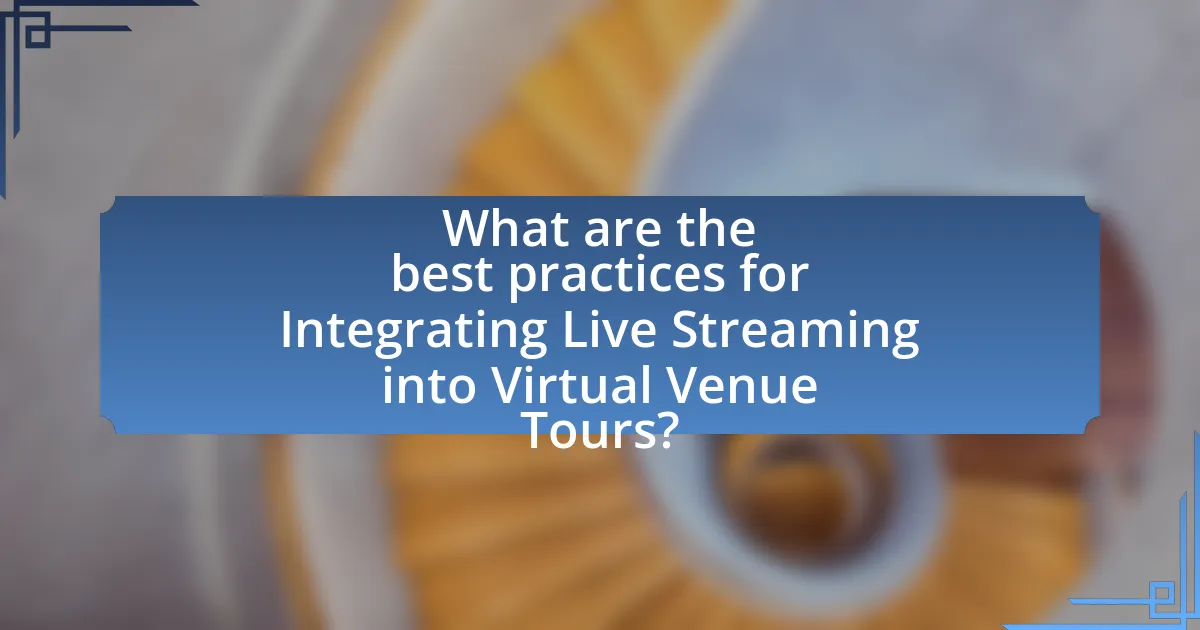
What are the best practices for Integrating Live Streaming into Virtual Venue Tours?
The best practices for integrating live streaming into virtual venue tours include ensuring high-quality video and audio, engaging with the audience in real-time, and providing interactive features. High-quality video and audio are essential for creating an immersive experience; studies show that 80% of viewers prefer high-definition content, which enhances viewer retention. Engaging with the audience through live Q&A sessions or polls fosters interaction and keeps viewers invested in the tour. Additionally, incorporating interactive features, such as clickable hotspots or virtual reality elements, can significantly enhance user experience, as evidenced by a report from the Virtual Reality Developers Conference, which found that interactive content increases viewer engagement by up to 70%.
How can content be effectively planned for live streaming?
Content can be effectively planned for live streaming by establishing clear objectives, understanding the target audience, and creating a structured outline of the content to be presented. Defining objectives ensures that the live stream has a purpose, such as educating viewers about a venue or showcasing specific features. Understanding the target audience allows for tailoring the content to their interests and preferences, which can enhance engagement. A structured outline helps in organizing the flow of the live stream, ensuring that all key points are covered in a logical sequence. For instance, a study by the Interactive Advertising Bureau found that 54% of consumers want to see more video content from brands they support, highlighting the importance of engaging content in live streaming.
What types of content resonate best with audiences during live tours?
Interactive content resonates best with audiences during live tours. This includes real-time Q&A sessions, polls, and behind-the-scenes footage, which actively engage viewers and create a sense of participation. Research indicates that interactive elements can increase viewer retention by up to 70%, as they foster a connection between the audience and the content being presented. Additionally, personalized experiences, such as tailored recommendations based on audience preferences, enhance engagement and satisfaction during live tours.
How can presenters engage viewers in real-time?
Presenters can engage viewers in real-time by utilizing interactive tools such as live polls, Q&A sessions, and chat features during their presentations. These tools allow presenters to solicit immediate feedback and foster a two-way communication channel, enhancing viewer participation. For instance, a study by the Pew Research Center indicates that 73% of online audiences prefer interactive content, which demonstrates that engagement strategies significantly improve viewer retention and satisfaction. By incorporating these interactive elements, presenters can create a dynamic and responsive environment that keeps viewers actively involved throughout the presentation.
What technical considerations should be addressed?
Technical considerations for integrating live streaming into virtual venue tours include bandwidth requirements, video resolution, latency management, and platform compatibility. Bandwidth must be sufficient to support high-quality video streaming without interruptions; for instance, a minimum of 5 Mbps is often recommended for HD streaming. Video resolution should be optimized for both the streaming platform and the end-user devices to ensure clarity and engagement. Latency management is crucial to provide real-time interaction; ideally, latency should be kept under 2 seconds to maintain a seamless experience. Lastly, ensuring compatibility across various devices and operating systems is essential for maximizing audience reach and engagement. These considerations are critical for delivering a successful live streaming experience in virtual venue tours.
How can bandwidth issues be managed during live streaming?
Bandwidth issues during live streaming can be managed by implementing adaptive bitrate streaming, which adjusts the video quality in real-time based on the viewer’s internet speed. This technology ensures a smoother viewing experience by reducing buffering and interruptions, as it dynamically changes the stream quality to match available bandwidth. According to a study by Akamai, adaptive bitrate streaming can improve user experience by up to 50% in environments with fluctuating bandwidth. Additionally, optimizing network infrastructure, such as using Content Delivery Networks (CDNs), can further enhance streaming performance by distributing content closer to users, thereby reducing latency and improving load times.
What equipment is necessary for high-quality streaming?
High-quality streaming requires a reliable camera, a good microphone, and a stable internet connection. A high-definition camera, such as a DSLR or mirrorless camera, captures clear video, while a quality microphone, like a condenser or lavalier mic, ensures clear audio. A stable internet connection with at least 5 Mbps upload speed is essential to prevent buffering and maintain stream quality. These components collectively enhance the viewer’s experience by providing clear visuals and sound, which are critical for engaging audiences during virtual venue tours.
What tips can enhance the overall experience for viewers?
To enhance the overall experience for viewers during virtual venue tours integrated with live streaming, ensure high-quality video and audio production. High-definition visuals and clear sound significantly improve viewer engagement and satisfaction, as studies show that 80% of viewers are more likely to stay engaged with high-quality content. Additionally, incorporating interactive elements such as live Q&A sessions and polls can foster real-time engagement, making viewers feel more involved. Research indicates that interactive content can increase viewer retention by up to 70%. Lastly, providing a well-structured narrative and clear guidance throughout the tour helps maintain viewer interest and understanding, as a coherent storyline is essential for effective communication in virtual environments.
How can pre-tour promotions maximize viewer participation?
Pre-tour promotions can maximize viewer participation by creating anticipation and excitement around the event. Effective strategies include targeted social media campaigns, exclusive sneak peeks, and engaging content that highlights unique aspects of the tour. For instance, a study by Eventbrite found that events with strong pre-event marketing saw a 30% increase in attendance compared to those without. By leveraging email marketing and influencer partnerships, organizers can reach wider audiences and encourage early sign-ups, further enhancing viewer engagement.
What follow-up strategies can maintain engagement post-tour?
To maintain engagement post-tour, implementing personalized follow-up communication is essential. This can include sending tailored emails that recap the tour highlights, share additional resources, or offer exclusive content related to the venue. Research indicates that personalized emails can increase engagement rates by up to 29%, demonstrating their effectiveness in keeping the audience connected. Additionally, utilizing social media platforms to share behind-the-scenes content or user-generated posts can foster a sense of community and encourage ongoing interaction. Engaging participants through surveys or feedback forms can also provide valuable insights while making them feel valued, further enhancing their connection to the venue.
